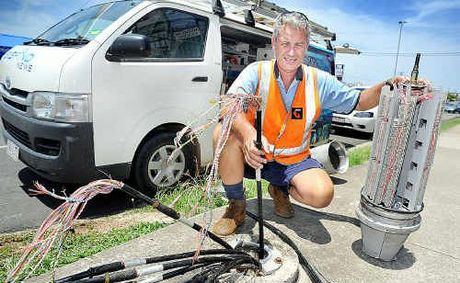
Telco e-Bulletin 2013 - #17
- Permanent workforce a priority says Telstra
- ISGM trainees: CWU concerns continue
- Membership alert: proposed changes to Telstra incentive payment schemes
- Telstra award modernisation: FWC asks for progress report
- Optus award modernisation
- CWU meets with Telstra on NBN skills
- TPG flags 100Mbps fibre plans
- Coalition wastes no time attacking workers
- Zero hours contracts: a new plague
- US income inequality rises to historic levels
1. Permanent workforce “a priority” says Telstra
Telstra has told the CWU that its permanent workforce remains its priority despite the rise in the number of sub-contractors it plans to use in the installation/maintenance area.
Telstra’s plans to boost the number of its ISGM sub-contractors through an accelerated traineeship programme have set alarm bells ringing among its internal Customer Field Workforce.

Not surprisingly, Telstra employees want to know whether they are simply training their own replacements.
The CWU has made a number of representations to Telstra on this question and asked for assurances about the company’s workforce development plans, especially those relating to future work opportunities for field staff such as those relating to the NBN project.
We pointed out that members are frustrated that they are not being released for NBN training despite Telstra having a $100m government grant to provide it.
On 16 September, Telstra responded formally to the CWU, stating that the ISGM training programme is designed to “enable Telstra to meet current demand and assist with workloads whilst Telstra trains its permanent workforce with the skills for future work”.
“For the foreseeable future Telstra has no intention to replace its existing field workforce with third party contractors.”
Telstra letter for CWU, 16 September 2013
The CWU welcomes these commitments by Telstra.
We of course want certainty for our members and other Telstra employees. But the union also believes that the retention and development of a diverse, skilled and secure internal workforce is a competitive advantage for the company itself.
The CWU will continue to press this point with Telstra. Members are also urged to continue to report any instances of training being refused and/or Telstra employees being made redundant while contractors are being used to do the same work.
The union would also like to hear of any instances of Telstra trainees (i.e. from Excelior) being engaged as labour hire workers rather than as permanent Telstra employees.
2. ISGM trainees: CWU concerns continue
While the CWU has welcomed Telstra’s commitments to its own workforce, it continues to have concerns about the contractor training programme that ISGM is conducting with Telstra support.
This programme aims to turn out some 400 or more new ISGM sub-contractors to work on the Customer Access Network (CAN) over the next 6 -8 months. It provides 32 weeks of off-the-job and on-the-job training resulting in a Certificate III qualification.

Such a time span provides a much greater opportunity for the trainee to become fully competent through day-to-day work experience.
How many of the people put through the “accelerated” programme (all of them formerly unemployed) will actually be able do the job? And if they struggle, what assistance will they get? After all their survival as “independent” sub-contractors will depend on how many jobs they can do a day.
They will also be required to set themselves up as small business operators. Where will they find the resources and know-how to do that?
The CWU is continuing to seek information about these arrangements, including the details of the training that is being given. Our aim is to ensure that training standards are maintained and that workers in the industry, whether employees or contractors, are properly equipped to earn a decent living in it.
3. Membership alert: proposed changes to Telstra incentive schemes.
Telstra has advised the CWU that it proposed to make changes to its incentive-based pay schemes. It was briefed on the plan by the company at a meeting on Friday 20 September.
Telstra intends to shut down the current Customer Services Incentive (CSI) plan after the end of December this year. The plan is currently available to Communication Technician (CTs) in Customer Service Delivery and Networks Delivery Customer Service.
No replacement scheme is being developed for Workstream employees. Workstream employees would continue to have access to the Customer Satisfaction Bonus but not to any performance-based incentive pay scheme.
So Workstream CTs wanting to earn performance-based incentive payments over and above their fixed remuneration would have to move to the Job Family.
The incentive scheme for Job Family employees is currently being restructured and the CWU expects more detailed information about it to be available next week. In the meantime though, CWU members are strongly advised not to make any commitments to changing their current employment arrangements.
Telstra has never made any secret of the fact that it would like all employees on the Job Family model. The Job Family pay system gives Telstra management much more power to determine an individual employee’s actual pay, including any pay increases. And that means more power in the workplace generally.
So CTs should approach this current move by Telstra with caution.
It is true, as Telstra says, that the current CSI scheme is often unfair (e.g. to regional/rural staff) and often produces the wrong results (e.g. poor work quality). That is why many members don’t participate in it at all or do so only half-heartedly.
But a few members will be making good money over and above their Fixed Remuneration and may now be tempted to move across to the Job Family to get access to a similar incentive scheme.
CTs should think more than twice before making that move. The Workstream model offers pay certainty. Workstream employees are guaranteed a good wage –and equally importantly union negotiated wage rises –no matter what sort of relationship they have with their team leaders and managers.
Wage rises for Job Family workers are set on an individual basis and depend largely on the assessment of the local manager –and on the local budget. In fact a few years ago many Job Family employees had a total wage freeze for two years!
So dollars won through participation in a Job Family participation scheme can be lost, over time, at the Fixed Rem level.
The CWU will relay any further information it has on this proposal as it receives it. Meanwhile, remember that any move to the Job Family is entirely voluntary. Workstream-based members should immediately report any pressure from local management to move to the Job Family to their state branch,
4. Telstra award modernisation: FWC asks for progress report
The Fair Work Commission has asked Telstra and the Telstra unions to report on their progress in modernising the Telstra awards.
It is now over a year since the Commission rejected Telstra’s application to cancel its existing awards and move to the modern industry award, the Telecommunications Services Award.
Since that time the CWU has been working with the other Telstra unions to develop a modern enterprise award but progress has been slow and, as reported in E-bulletin # 12 there is still a number of significant differences between Telstra and the unions on a range of matters.
Because of this slow progress, Deputy President Lawler called the parties together last month to see whether they might require the involvement of the Commission. Both Telstra and the unions indicated that while they might seek such assistance in future, they wished at present to continue current discussions.
The unions will be meeting with Telstra again in early October when we expect to have a comprehensive proposal from the company about the content of the award. Members will be kept informed of further developments.
5. Optus award modernisation
Optus has told the CWU that it will be ready to discuss the future of the current Optus enterprise award by the end of next month.
Under current law, companies and unions which are party to enterprise awards have to apply to modernise them before the end of this year. If no application is made by that time, the awards cease to exist and are replaced by the modern industry award – in this case, as with Telstra, the Telecommunications Services Award (TSA).
The CWU understands that Optus wishes to retain an enterprise-specific award, rather than move to the TSA.
Under current laws, the Fair Work Commission has to take the views of Optus employees into account when making a modern award. So the question for Optus employees will be which award provides the better “safety net” for enterprise bargaining.
The current Optus award contains some key provisions which are clearly better than those in the TSA. For instance, the award provides for a redundancy payout of up to 40 weeks. (The CWU was successful in increasing this to 44 weeks in the most recent Optus agreement.) The maximum payout under the TSA is 16 weeks.
The CWU will be aiming at protecting such entitlements in the upcoming discussions with Optus while also looking to see if there are ways the award can be strengthened.
Members will be informed of further progress on these issues.
6. CWU meets with Telstra on NBN skills
The CWU met with Telstra on Thursday 19 September for the regular quarterly briefing on NBN-related training. Representatives of the Department of Broadband, Communications and the Digital Economy (DBCDE) also attended.
The training scheme is supported by $100m in Commonwealth funding and is specifically designed to provide fibre-related skills to Telstra employees who might otherwise be made redundant by the NBN project.
A second objective is to help develop a workforce to assist in the NBN roll-out itself.
Telstra has to date played a limited role in NBN construction. For that reason much of the training to date has focussed on work that needs to be done inside the customer premises. This includes training for Cabler Provider Rules (CPR) endorsements in fibre and Cat5/6 cabling and for installation and integration of digital products in the home/small business environment.
More recently, as a sign that it may play a larger role in NBN construction in future, Telstra has begun developing new training courses for scoping and design of fibre networks.
Some 70 employees, drawn largely from the former Network Construction, have already been given training in this area with a target of 110 to be trained over the current financial year.
Altogether Telstra reports that it has provided training to some 2,000 employees over the last financial year, with over half of these now trained to the point where they will be “work ready” in a fibre environment.
Telstra has previously indicated that it has over 6,500 employees who will be eligible for retraining under the terms of its agreement with the Commonwealth so the 8 year programme can be expected to ramp up further over the next 12 months.
In the meantime, though, members should alert their state branches to any difficulties they are experiencing in getting release for training.
7. TPG flags 100 Mbps fibre plans
Stand aside NBN Co. Second tier telco TPG has announced plans to roll out a Fibre-to-the-Building (FTTB) service to some 500,000 premises starting at the end of this year.
The proposed roll-out will take fibre to the Main Distribution Frame (MDF) of multi-dwelling units (MDUs) and then use high rate (vectored) VDSL to take services to individual customers – a common strategy, especially in countries with a high proportion of such high density housing.
Providing fibre all the way to each unit in MDUs is both costly and potentially complex, both practically and legally - as NBN Co has discovered.
The company has made slow progress in this section of the market and CEO Mike Quigley at one point publicly canvassed the FTTB option as an alternative to full fibre-to-the-unit provision.
The suggestion was promptly dismissed by then Communications Minister Stephen Conroy.
Now, ironically, TPG and any other carrier which cares to risk its arm is looking at a virtually untapped market in this area – unless current regulation bars the way.
The regulatory framework put in place around NBN Co is designed to shield the company from such “cherry picking” competition in order to protect the cross-subsidies involved in its nationally uniform prices.

TPG’s move will provide the first major practical challenge to the wholesale fibre monopoly model put in place by Labor.
The Coalition’s policy is to support the competitive supply of broadband infrastructure. But it may not have anticipated such an immediate response to the opportunities its policy opens up.
TPG has said it intends to begin its roll-out by Xmas – long before the Coalition will have had time to reorient the NBN project to Fibre to the Node (FTTN) and to make any related regulatory adjustments, particularly to wholesale pricing structures.
With Optus also speculating publicly on a “last mile” fibre roll-out, Communications Minister Malcolm Turnbull will have to make some quick decisions if the new Government wants to stay ahead of the policy game.
8. Coalition wastes no time in attacking workers
The newly-elected Abbott government has wasted no time in attacking Australian workers.
Within days of the federal election, the Coalition announced that it would cancel a Commonwealth funding deal which would have seen pay increases for 350,000 aged and child care workers. The arrangements would have seen increased funding for providers tied to guarantees of decent wages for their employees through enterprise agreements.

ACTU President Ged Kearney said that the decision was a betrayal of a group of low paid workers, most of whom were women.
“Aged and childcare workers do a very tough job and are paid very little and any move to deny their pay increases demonstrates a worrying lack of understanding,” she said.
“Aged care is one of the most important and difficult jobs there is, yet aged care workers are amongst the lowest-paid.”
Ms Kearney said in order to be an effective government the Coalition and Tony Abbott would need to get a firm grasp of the challenge of an aging population and staff shortages.
“It is absolutely critical we build our aged care workforce to manage the needs of our growing population,” said Ms Kearney.
“Lifting pay is central to attracting and retaining skilled workers in this field.”
9. Zero-hours contracts: a new plague
As many as 5.5 million UK workers may be signed up to work contracts that promise them less than three hours of work a week, the Guardian newspaper reports.
A survey conducted by one of Britain’s biggest unions, Unite, found that 22% of workers employed by private businesses had deals that offered little or no guarantee of work and pay. That’s nearly 5 times more than previous estimates.

According to the Unite study, 36% of those on the contracts said they did not receive holiday pay and 77% got no sick pay.
In a rebuff to those who suggest workers can enjoy the benefits of flexible working, 87% said they would prefer not to be on a contract which could promise less than three hours work a week.
“Zero Hours” contracts have spread like a disease in the UK, especially in the wake of the Global Financial Crisis. As is the case in the US, a large proportion of the new jobs that have appeared since 2008 are low paid and/or part-time and insecure. “Zero hours” contracts lock workers into this situation.
Most of those on the contracts are aged between 18 and 24 years of age, and the numbers in this age range employed on this basis has more than doubled since 2008.
“Zero hours” contracts represent the next step beyond casualisation when it comes to exploitation of workers. The casual worker has some degree of control over whether they work or not, at least legally.
The Australian labour movement needs to be on its guard against the introduction of such practices here, especially given the pro-employer policies we can expect from the Abbott government.
10. US income inequality rises to historic levels
Three years into the supposed “recovery” of the US economy after the Global Financial Crisis, economic inequality in that country is at levels not seen for nearly a century.
And at a time when the top 10% of the population is taking in more than half of all national income, 46.5 million Americans, including 9.5 million families, live in poverty.
This is the startling picture painted by a number of recent reports on the distribution of wealth in today’s USA.
A US Census Bureau report released on 17 September entitled “Income, Poverty and Health Insurance Coverage in the United States: 2012,” revealed that some 20.4 million people live on an income less than 50 percent of the official poverty line, 7.1 million of these being children under 18. More than 48 million remain without health insurance.
The same week, Forbes magazine produced its annual “rich list”. It showed the combined wealth of the top 400 “rich” individuals rose substantially from the previous year—from $1.7 trillion to $2.2 trillion, a figure equal to 12 percent of the total annual gross domestic product (GDP) of the United States and two-thirds of the tax revenues collected in the US in 2013.

So while the US economy may be recovering –slowly – the benefits of that recovery are flowing very much one way. Another economic study found that 95% of national income growth between 2009 and 2012 went to the top 1% of earners. Income for the bulk of the population fell sharply.
These trends are not accidental or inevitable. They are the result of government policies that have diverted billions of tax dollars into propping up the big financial institutions at the expense of social programmes.
At the same time rising unemployment has put pressure on wages. The share of national income going to labour in the US is at historic lows.
These statistics point to a deepening social division in the US and are a warning to Australian working people.
It is possible to go backwards. The labour movement must be ready to fight the inevitable attacks on wages, entitlements and living standards that will be launched by the Coalition government, if not today, then tomorrow.










